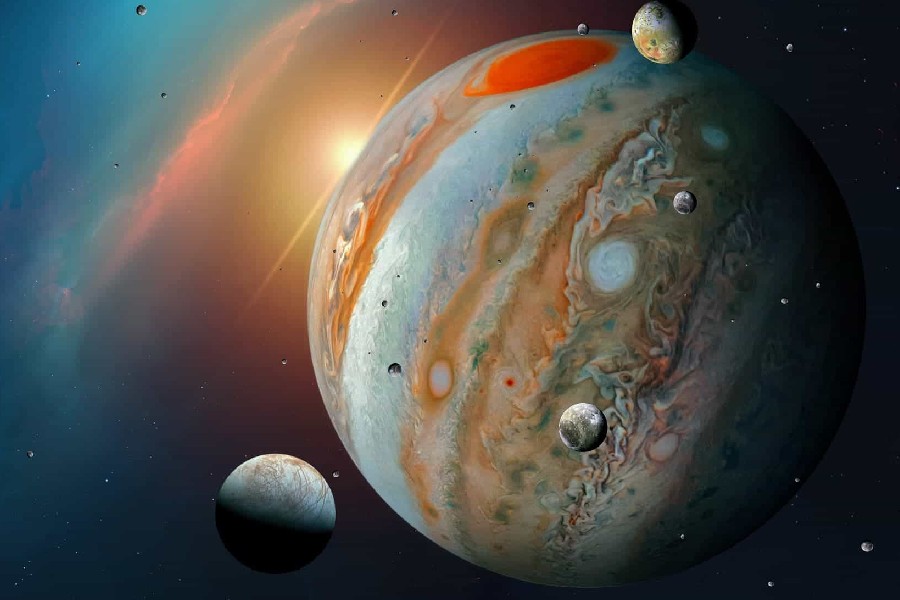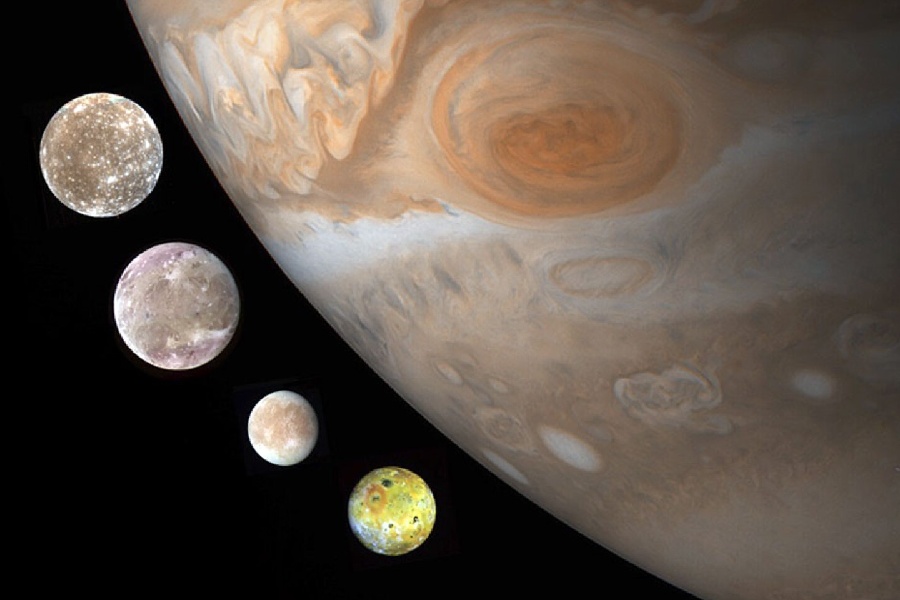Among the brilliant dots of light that grace our night skies, few sights compare to Jupiter and its stately procession of Galilean moons. Yet for all its familiarity over thousands of years of astronomical records, the exact multitude of Jovian moons has come into clear focus only recently. So, how many moons does Jupiter have?
The king of planets continues to assist astronomy and astrophysics with an abundance of discoveries. It reigns supreme, enriching our understanding of the cosmos without limit.
This article explores the fundamentals about Jupiter moons. We overview the history of discovery from earliest sightings through recent moon counts that continue rising with next-generation surveys.
Combining dynamical analyses and planetary formation models, we spotlight just how much Jupiter’s moons have yet to teach us about unraveling the origin of worlds themselves. Its moons, offering a mesmerizing dance around this giant planet, each with its own unique characteristics and secrets, are waiting to be discovered.
How Many Moons Does Jupiter Have?
So, how many moons does Jupiter have? Jupiter, the largest planet in our solar system, boasts an impressive entourage of moons. As of the latest count, Jupiter has a staggering 95 known moons.
These natural satellites vary in size, composition, and orbital characteristics, contributing to the intricate orbit around the gas giant. Among the notable moons are the four largest, known as the Galilean moons – Io, Europa, Ganymede, and Callisto – discovered by Galileo Galilei in 1610.

Discovery of Jupiter’s Moons
Galileo’s observations
In 1610, Galileo Galilei first turned a rudimentary telescope to Jupiter and detected 3 then 4 bright attendants moving around the planet – confirmation of Copernicus’ heliocentric model that not everything orbits Earth.
Now known as the Galilean moons, Galileo’s discovery of Io, Europa, Ganymede, and Callisto orbiting Jupiter contributed greatly to overturning the geocentric paradigm and revealed the immense scale of the outer solar system.
The Galilean moons
The four largest Jovian moons spotted by Galileo – Io, Europa, Ganymede, and Callisto – range dramatically in properties but all offer profound revelations. Volcanic Io showcases extreme internal heat fluxes.
Icy Europa’s subterranean ocean makes it a prime astrobiological target. Ganymede constitutes the largest moon in the entire solar system while outermost Callisto may shield a subsurface salty ocean. Together the Galilean moons provide archetypes for diverse worlds.
Total Count and Classification
Current number of known moons
Jupiter, the largest planet in our solar system, boasts a remarkable entourage of moons, and scientists are continually discovering new ones. As of 2023, Jupiter has 95 confirmed moons. The extensive moon count underscores the dynamic nature of the Jovian system and the continuous advancements in observational technology.
Among the known moons, the vast majority are relatively small, irregularly shaped objects. Their diverse sizes and orbital characteristics contribute to the complexity of Jupiter’s moon system.
Advancements in telescopic technology and space exploration missions, such as Galileo, Juno, Voyager 1, Voyager 2, Pioneer 10, and Pioneer 11, have played pivotal roles in expanding our understanding of these celestial companions.
Categories of Jupiter’s moons
Jupiter’s moons can be broadly categorized into several groups based on their distinct characteristics and orbital properties.
- Galilean moons – These are the four largest and most well-known moons discovered by Galileo Galilei in 1610. They include Io, Europa, Ganymede, and Callisto. Each Galilean moon is a world in its own right, offering unique features and scientific intrigue.
- Regular satellites – This category includes numerous smaller moons that follow more predictable, circular orbits around Jupiter. These moons exhibit greater orbital stability compared to irregular moons.
- Irregular moons – These are characterized by more eccentric orbits and larger size variations. The irregular moons are further divided into subgroups, reflecting their diverse origins and evolutionary histories.
Understanding the classification of Jupiter’s moons is crucial for unraveling the complex dynamics of the Jovian system and shedding light on the broader processes governing the formation and evolution of planetary moon systems.
Ongoing research and future space missions are expected to unveil even more details about these fascinating celestial bodies.

Galilean Moons: A Closer Look
Io – The volcanic moon
The innermost of Jupiter’s big moons, Io dazzles with over 400 raging active volcanoes spewing sulfur plumes up to 186 miles high – the most anywhere. Intense tidal flexing from Jupiter and neighboring large moons generates Io’s mammoth internal heat flow, melting its silicate core.
Ionic volcanic eruptions paint Io with fiery hues. Studying Io advances understanding of tidally-active worlds.
Europa – An icy world with hidden oceans
Covered by a frozen icy crust, Europa shows evidence of a subterranean saltwater ocean more than 60 miles deep containing more liquid water than Earth, making it potentially habitable. Powerful tidal forces from Jupiter likely heat Europa’s insides, keeping its global ocean liquid.
Plume eruptions through its fractured bright lanes may provide samples of its watery depths. Upcoming probes aim to further study this compelling astrobiological target world.
Ganymede – The largest moon in the solar system
The largest moon orbiting any planet, Jupiter’s Ganymede exceeds even Mercury in diameter at over three thousand miles across.
Ganymede displays contrasting cratered dark ancient terrain and grooved swaths of rejuvenated icy landscape – hints of past internal heating still driving periodic resurfacing through water migration between subsurface layers today. An underground salty ocean could interact with its core.
Callisto – A moon of mysteries
While crater-saturated Callisto appears long dead externally, scientists believe that there might be a salty ocean beneath its surface. This ocean might be protected from Jupiter’s magnetic field, which could remain unfrozen if there is enough heat circulation.
By using ice penetrating probes or surface drillers, scientists could investigate the intricate internal structures of Callisto to determine its potential for supporting life and gain valuable insight into how planets form. Callisto still holds many mysteries beneath its heavily cratered surface.
Other Notable Moons
Amalthea and Himalia
Beyond the Galilean quartet, Jupiter hosts other intriguing moons – like cratered, reddish Amalthea, lurking just above Io’s orbit. Whereas Himalia represents the largest member of a group that may have formed around another star before being captured.
Analysis of these smaller moons advances models on the spectrum of possible formation pathways.
Captured moons vs regular moons
Jupiter’s dozens of known farther moons fall into two broad classes – regular and irregular. Regular prograde moons likely coalesced from the same spinning disk of material surrounding Jupiter like the Galilean satellites.
By contrast, the asynchronous, inclined, retrograde orbits of irregular moons indicate Jupiter gravitationally seized them after formation – immigrants from beyond.
Comparing differences in composition and orbital characteristics between these groups provides insights into solar system dynamics.
Jupiter’s Magnetosphere
With an enormous magnetosphere spanning over four million miles wide, Jupiter boasts the largest solitary planetary magnetosphere in our solar system – a harsh radiation-filled plasma dynamo dominated by inputs from its moons.
Sheer scale
Jupiter’s magnetosphere stretches over 12 times wider than Earth’s due to Jupiter’s rapid rotation and immense internal liquid metallic hydrogen dynamo that generates an extraordinary magnetic field. Centrifugal acceleration of plasma particles hurls ionized particles outward in a flattened disc around the planet’s equator.
Rotational powerhouse
This disc generates immense electric currents hundreds of millions of amperes strong. These in turn create vast auroral displays that would eclipse a thousand Earths in intensity.
Over one billion watts of heat dissipation from energetic charged particle bombardment in Jupiter’s upper atmosphere gives rise to the planet’s dazzling northern and southern lights.
Io’s volcanic contributions
Jupiter’s moon Io contributes over two thousand pounds per second of material into the Jovian magnetosphere through its hyperactive volcanism.
Io essentially acts as a power plug, driving up to two million amperes of electrical current along magnetic flux tube pathways between Jupiter and the volcanic moon. These currents provide energy for two of Jupiter’s brightest auroral features dubbed “the Io footprint”.
Conclusion
Exploring the expanding multitudes orbiting the king of planets, it becomes clear that determining how many moons does Jupiter have doesn’t have a conclusive answer as next-generation surveys inspire even greater revisions.
Yet each moon seen clearly for the first time writes a new line in the grand story of solar system history. Jupiter’s moons showcase a spectacular diversity of worlds, illustrating many possible outcomes of planetary origins and evolution.
Seeing this diversity is helpful for developing theories on how planets and moons form. As future probes reach unexplored areas around Jupiter, these theories will be tested while deepening our understanding of planetary science.
